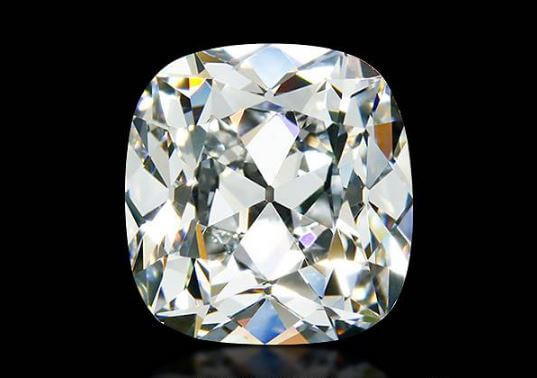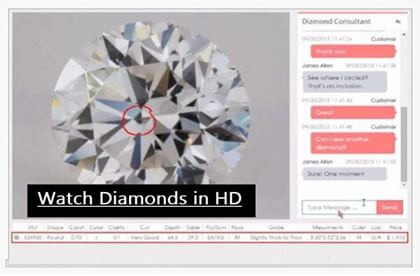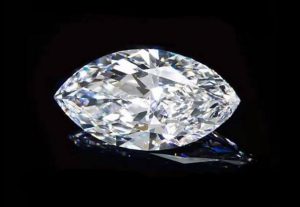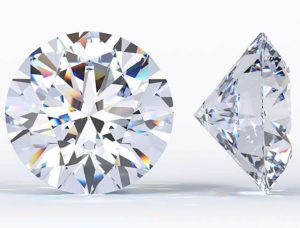Executive Summary
A lot of improvement was made to this diamond after Marcel Tolkowsky’s work in the 20th century. The culet was shrunk, the table was enlarged and the cut angles improved to increase the diamond’s brilliance and this has made the cushion cut better compared to the old mine cut.
The most appealing quality of the cushion diamond is the fire. It has more fire than the round diamond although, it is not as brilliant.
The pavilion facet of the cushion diamond has 3 different basic patterns. The third pattern is referred to as the modified cushion because of its extra row of facets. The facet pattern can either be crushed ice or needle-like pattern.
The ideal length to width ratio of the square-shaped cushion cut diamond is 1.00. While the length to width ratio for the rectangular cushion cut diamond is 1.10 – 1.20.
You can save money on diamond color when you combine with the setting. If you are setting your cushion diamond in a white gold setting, it allows you to go down the color grade to H, I, or J. if you’re choosing a yellow gold or rose gold setting, grade I or J diamond will still appear colorless.
The crushed ice or chunky pattern of the cushion diamond affects the diamond’s clarity. The crushed ice pattern hides impurities that may be present in the diamond allowing you to go further down the clarity scale. On the other hand, the chunky pattern tends to reveal impurities in the diamond. So you have to go a little bit higher up the clarity scale if you are buying one. You have to pay attention to this when buying a cushion diamond. The most important thing, however, is to buy a diamond that is clear to the naked eye.
The cushion cut diamond has a long history that dates back as far as the 19th century. This diamond cut was originally called the mine cut but the name has changed through the years as and it is now referred to as the old mine cut. This old mine cut has a square shape but the corners were round. It was first named after the diamond mines in Brazil at the time. But the discovery of diamonds in South Africa led to the famous diamond mines in Brazil being called the “old mines”. This consequently changed the name of the diamond that was named after the “old mines” too.
Although the cushion diamond evolved from this old mine cut diamond, they are not actually alike in many ways. It is not just the name that changed, the total number of the facet that they have also changed. The old mine cut was known to have 58 facets in total (25 pavilion facets and 33 crown facets). This is so unlike the modern cushion cut diamond which has 6 more facets than the old mine cut diamond with a total of 64 facets. Another difference between these two old and modern cuts is their brilliance. The cushion cut diamond is a more brilliant diamond than its older counterpart.
The cushion cut diamond can be found in both square and rectangular shapes and the edges are rounded just like its preceding old cut diamonds. This square shape and rounded edges give it an appearance like that of a pillow. That is how it got the name cushion cut.
Analysis of the Cushion Cut Diamond
The resurgence of this diamond cut is partly due to the research carried out by Marcel Tolkowsky early in the 20th century. And this has led to the cushion cut being reformed in many ways, from the shrinking of the culet, enlargement of the tables and improvements made to the cut angles to increase brilliance. All these improvements have made the cushion cut a lot better than the older counterpart and have increased its popularity among diamond buyers in recent years.
Although the cushion cut is a brilliant diamond, it is not as brilliant as the round cut diamond but it has a better fire and that is one of the factors that makes it very appealing to buyers.
There are three different basic patterns for the pavilion facets of cushion cut diamonds. The pavilion of the diamonds with this third pattern has another row of facets in them and are classified as the modified cushion by the GIA. The facet pattern for this modified cushion cut can be needle-like or it could be a crushed ice pattern. This pattern does not resemble the traditional cushion cut pattern but actually resembles the radiant cut.
The ideal length to width ratio of the square-shaped cushion cut diamond is 1.00. While the length to width ratio for the rectangular cushion cut diamond is 1.10 – 1.20.
The tables below will serve as a guideline to help you to evaluate the cut of this diamond and the length to width ratio based on the different shapes (square or rectangle).
Cut Guide for Cushion Cut Diamond
| EXCELLENT | VERY GOOD | GOOD | FAIR | POOR | |
| TABLE | 61 – 67 | 58 – 60 or 68 – 70 | 56 – 57 or 71 | 54 – 54 or 72 – 73 | < 54 or > 73 |
| DEPTH | 61 -67 | 58 – 60.9 or 67.1 – 70 | 56 – 57.9 or 70.1 to 71 | 54 – 55.9 or 71.1 – 73 | < 54 or > 73 |
| GIRDLE | Very thin to slightly thick | Very thin to slightly thick | Very thin to thick | Very thin to very thick | Ex. Thin to Ex. Thick |
| CULET | None | Very small | Small | Medium | >Medium |
Length to Width Ratio Guide for Cushion Cut Diamond
| EXCELLENT | VERY GOOD | GOOD | FAIR | POOR | |
| Square | 1.00 – 1.03 | 1.00 – 1.03 | 1.04 – 1.05 | 1.06 – 1.08 | > 1.08 |
| Rectangle | 1.15 – 1.20 | 1.10 – 1.14 or 1.21 – 1.30 | 1.10 – 1.14 or 1.21 – 1.30 | 1.08 – 1.09 or 1.31 or 1.50 | < 1.08 or > 1.50 |
The Color of Cushion Cut Diamond
Diamonds come in a variety of colors. The GIA has a grading system by which we can use to analyze the color grade of a diamond. The colors vary from grade D down to grade Z. It takes a professional gemologist or an expert to really distinguish these color grades. A buyer, it is actually impossible for you to know the real color grade of a diamond. While most of the diamonds are colorless, some diamonds in the lower color grades are said to contain yellow or brown tints that are noticeable to the eye. So many buyers would prefer to stay with the higher color grades when buying diamonds and this invariably leads to an increase in the price of diamonds within those color grades that are well sought after. But generally, the difference in color grades is not easily noticed, especially by the naked eye. So when considering the color grade of a diamond you are interested in buying, you should go for a colorless diamond, not necessarily the most colorless diamond. The thing is, you really do not have to go for a grade D diamond and pay more for it, when you can settle for a grade H or grade I diamond, that is also colorless to the naked eye, and pay less for it. It just makes more business sense, and it saves you some money. If you are looking for a cushion cut diamond with the white gold setting, you can settle for grade H or even grade I or grade J, depending on the size of your pocket, and you will still have that colorless diamond with you while paying lesser. If the setting is yellow gold or rose gold setting, you can opt for a grade I or grade J diamond, and it will still appear white or colorless. This just makes a lot of business sense and saves you a lot of bucks, unless you have money that you don’t want and want to do away with. The table below will give you an idea of how to evaluate the color of the cushion cut diamond.
| EXCELLENT | VERY GOOD | GOOD | FAIR | POOR | |
| < .50 ct. | D – G | H – I | J – K | L – M | > M |
| .51 – 1.0 ct. | D – F | G | H – I | J – K | > K |
| 1.0 – 2.0 ct. | D – F | D – F | G – H | I – J | > J |
| >2.0 ct. | D – F | D – F | G | H – I | > I |
| Fluoro | None | Faint – medium | Strong | Very Strong | Very Strong |
The Clarity of Cushion Cut Diamond
The kind of pattern the cushion cut diamond has is something that you have to put into consideration when you are choosing the clarity of your diamond. The chunky pattern and the crushed ice cushion pattern have a way of influencing the overall clarity of the diamond.
The crushed ice pattern in the cushion diamonds tends to hide the impurities and flaws that may be present in the diamond. The arrangement of this facet pattern makes it difficult for you to see the impurities that are present in the diamond. On the other hand, the chunky pattern tends to reveal any impurities, flaws or inclusions that are in the diamond. The arrangement of this pattern with its distinct facets makes it less forgiving than the crushed ice pattern. This is a very important fact to take note of when buying your cushion cut diamond. However, the most important thing to consider is whether or not the diamond is eye-clean. That is, you have to ensure that there are no visible inclusions in the diamond. The pattern of the facet or the clarity grade of the diamond would no longer be important if I can look through it and spot a flaw. So you must be careful of visible flaws. You wouldn’t like to attend that event with a flaw in your diamond, ruining what should have been a perfect appearance for you.
The GIA has a classification grade for the inclusions in a diamond. Ranging from diamonds that are internally flawless to the one with inclusions in them. The classification is as follows:
- IF – Internally Flawless
- VVS1 – Very Very Small Inclusions 1
- VVS2 – Very Very Small Inclusions 2
- VS1 – Very Small Inclusions 1
- VS2 – Very Small Inclusions 2
- SI1 – Small Inclusions 1
- SI 2 – Small Inclusions 2
- I1 – Inclusions 1
- I1 – Inclusions 2
To get the perfect midpoint between getting a cushion cut diamond with a high clarity grade and the best possible price, then you will have to settle for a diamond within a clarity grade of VS2 or SI1. You can also get diamonds in the SI2 clarity grade that would appear flawless to the eye. This will save you a little bit more cash. If you are working with a stricter budget and would like to stretch it a little bit further, you can also get some I1 grades diamonds that appear to be eye-clean. Don’t forget that the goal is not to get a flawless diamond but to get a diamond that does not have visible flaws in it and to actually save some money.
For diamonds within the SI1 and SI2 clarity grades, you have to check properly to make sure that the flaws in them are not too dark and too big, and they are also at the edges of the stone and not at the center because this makes it very noticeable. Anyway, if you are not sure about the clarity of the diamond you are about to buy, the best thing is to ensure that the diamond is reviewed by an expert. This is safe for you, as you won’t end up buying a wrong diamond at the wrong price. The table below will guide you properly in assessing the clarity of a cushion cut diamond.
| EXCELLENT | VERY GOOD | GOOD | FAIR | POOR | |
| .50 ct. | FL – VS2 | SI1 – SI2 | I1 | I2 | > I2 |
| .51 – 1.0 ct. | FL – VS1 | VS2 – SI1 | SI2 | I1 – I2 | >I2 |
| 1.0 – 2.0 ct. | FL – VVS2 | VS1 – VS2 | SI1 – SI2 | I1 | > I1 |
| > 2.0 ct. | FL – VVS2 | VS1 – VS2 | SI1 | SI2 | > SI2 |
The Carat Weight of the Cushion Cut Diamond
Diamonds come in different sizes and all of these sizes have a particular carat weight which they correspond to. The carat weight is a measure for pricing the diamonds based on their size. Consequently the size of a diamond (the carat weight) plays a very important role in determining the price of the diamond alongside other factors like cut, color, clarity etc. the common relationship between the size of the cushion cut diamonds and their carat weight is that an increase in size usually leads to an increase in carat weight and consequently, an increase in size.
The table below gives different sizes of the cushion cut diamond and their corresponding carat weight.
| Cushion diamond size | Cushion carat weight |
| 4.2 mm | 0.40 ct. |
| 4.9 mm | 0.50 ct. |
| 5.25 mm | 0.75 ct. |
| 5.5 mm | 1.00 ct. |
| 6.0 mm | 1.25 ct. |
| 6.5 mm | 1.50 ct. |
| 7.0 mm | 2.00 ct. |
| 7.5 mm | 2.50 ct. |
| 8.0 mm | 3.00 ct. |
| 8.5 mm | 3.50 ct. |
| 9.0 mm | 4.12 ct. |
| 9.5 mm | 5.09 ct. |
| 10.0 mm | 5.62 ct. |
It is important to note that when dealing with the carat weight of diamonds, no one sees the carat weight. So it would be a good idea for you to buy shy as this can also help you save some money. This is what I mean by buying shy, we have different carat weight corresponding to different sizes. There are diamonds of 2.0 ct., 1.5 ct., 3.0 ct., 4.5 ct., etc. diamonds with a whole mark or half mark carat weight. Rather than go for these whole or half mark carat weight, buying shy will means that you will instead settle for those slightly lower carat weights. For example, instead of buying a 3.0 carat weight cushion diamond, you can buy 2.9 carat weight cushion cut diamond. The difference in the carat weight is just 0.1 that’s hardly noticeable to the eye or the fingers wearing them. But the difference in their prices can be quite massive for such a difference in weight. This is what it means to buy shy. You’re getting something very similar to your desired carat weight but at a much cheaper price. Even you wouldn’t remember that it’s a 2.9 carat weight diamond and not a 3.0, but you definitely wouldn’t forget how much you were able to save from that difference.
So when it comes to buying a diamond, the 4 C’s, the cut, color, clarity, and carat weight of the diamond are all factors that you put together before making the choice. This guide below will help people with a restrained budget make their preferred choice.
An excellent choice
Criteria:
- The carat weight should be at least 1.0 carat weight.
- The polish and the symmetry must be excellent or very good at least.
- The color should not below grade G.
- The clarity should be from SI1 or higher than that.
- It should not have any fluorescence.
- The length to width ratio should be 1.0 – 1.05 if the cushion diamond is square-shaped or 1.12 – 1.30if the diamond is rectangular in shape.
A very good choice
Criteria:
- The carat weight should be at least 0.90 carat weight.
- The symmetry and polish must be between good and excellent.
- The color should be at least H and above.
- The clarity should be from SI1 or above that.
- It is best if it does not have any fluorescence. But medium blue fluorescent or faint fluorescence is still acceptable.
- The length to width ratio should be 1.0 – 1.05 if the cushion diamond is square-shaped but if it is rectangular in shape, the length to width ratio should be 1.12 – 1.30.
A good choice
Criteria:
- The carat weight should be at least 0.80 carat weights.
- The symmetry and polish should be good or very good.
- The color should not be a grade lower than I. it should be grade I or above.
- The clarity should not be below SI1 clarity grade. It should be this or higher than this.
- It is also best if it doesn’t have any fluorescence. But if it does, the fluorescence should be faint or medium blue. Those are acceptable.
- The length to width ratio should be 1.05 – 1.0 if the cushion diamond is a square-shaped one. But otherwise, if it is rectangular, the length to width ratio should be 1.12 – 1.30.
Depending on how tight your budget is, you could settle for any of these three options and you would be sure that you have a good diamond in hand. But settling for anything lesser than this might be too risky a thing to do.




